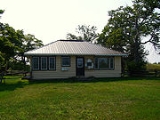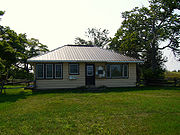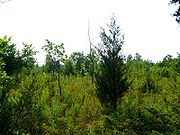
Prince Edward Point Bird Observatory
Encyclopedia


Bird observatory
A bird observatory is a centre for the study of bird migration and bird populations. They are usually focused on local birds, but may also include interest in far flung areas. Most bird observatories are small operations with a limited staff, many volunteers and a not-for-profit educational status...
located in the Prince Edward Point National Wildlife Area, located on Prince Edward Point in the south-east corner of Prince Edward County
Prince Edward County, Ontario
Prince Edward County is a single-tier municipality and a census division of the Canadian province of Ontario.-Geography:Prince Edward County is located in Southern Ontario on a large irregular headland or littoral at the eastern end of Lake Ontario, just west of the head of the St. Lawrence River...
, Ontario
Ontario
Ontario is a province of Canada, located in east-central Canada. It is Canada's most populous province and second largest in total area. It is home to the nation's most populous city, Toronto, and the nation's capital, Ottawa....
, Canada
Canada
Canada is a North American country consisting of ten provinces and three territories. Located in the northern part of the continent, it extends from the Atlantic Ocean in the east to the Pacific Ocean in the west, and northward into the Arctic Ocean...
. The National Wildlife Area was established in 1978 covering 560 hectare
Hectare
The hectare is a metric unit of area defined as 10,000 square metres , and primarily used in the measurement of land. In 1795, when the metric system was introduced, the are was defined as being 100 square metres and the hectare was thus 100 ares or 1/100 km2...
s. The observatory was established in 1995 to monitor bird migrations across the point, continuing the work of the Kingston Field Naturalists who performed similar work in the 1970s and 1980s. The observatory was designated a Globally Important Birding Area in 1998 by the Canadian Nature Federation and Bird Studies Canada
Bird Studies Canada
Bird Studies Canada is Canada's national bird conservation organization.-Summary:The organization began as the Long Point Bird Observatory in 1960, changing its name in 1998 to reflect the growing national scope of its research programs...
. It is also an International Monarch Butterfly Reserve.
Role
The observatory's purpose is to observe the migratory bird populations. It does so through a combination of bird banding, daily censuses and observations.Funding for these activities comes from a variety of sources. In 2002, the Ontario Trillium Foundation
Ontario Trillium Foundation
The Ontario Trillium Foundation , is an agency of the government of Ontario and one of Canada’s leading grantmaking foundations. It was created in 1982...
awarded the observatory $150 000 to renovate the research station, stabalize the bird banding operations and develop outreach activities. Smaller grants have included a $5 000 donation from the George Cedric Metcalfe Foundation for a modern bird banding facility and a $7 000 grant from the Helen McCrea Peacock Foundation to construct blinds and observation platforms.
Ecology

Lake Ontario
Lake Ontario is one of the five Great Lakes of North America. It is bounded on the north and southwest by the Canadian province of Ontario, and on the south by the American state of New York. Ontario, Canada's most populous province, was named for the lake. In the Wyandot language, ontarío means...
. Off the edges of the point there are both shoal
Shoal
Shoal, shoals or shoaling may mean:* Shoal, a sandbank or reef creating shallow water, especially where it forms a hazard to shipping* Shoal draught , of a boat with shallow draught which can pass over some shoals: see Draft...
s and deeper waters. The point itself is limestone bedrock
Bedrock
In stratigraphy, bedrock is the native consolidated rock underlying the surface of a terrestrial planet, usually the Earth. Above the bedrock is usually an area of broken and weathered unconsolidated rock in the basal subsoil...
with a thin covering of unconsolidated Farmington loam top soil.
The point features an interior with primarily grassland
Grassland
Grasslands are areas where the vegetation is dominated by grasses and other herbaceous plants . However, sedge and rush families can also be found. Grasslands occur naturally on all continents except Antarctica...
and scrubland. Also present are small amounts of wooded swamp
Swamp
A swamp is a wetland with some flooding of large areas of land by shallow bodies of water. A swamp generally has a large number of hammocks, or dry-land protrusions, covered by aquatic vegetation, or vegetation that tolerates periodical inundation. The two main types of swamp are "true" or swamp...
s, shrub-lined pond
Pond
A pond is a body of standing water, either natural or man-made, that is usually smaller than a lake. A wide variety of man-made bodies of water are classified as ponds, including water gardens, water features and koi ponds; all designed for aesthetic ornamentation as landscape or architectural...
s, mixed forests and alvar
Alvar
An alvar is a biological environment based on a limestone plain with thin or no soil and, as a result, sparse vegetation. It is also known as a pavement barren although this term is also used for similar landforms based on sandstone. In the United Kingdom the exposed landform is called a limestone...
s. Both sand
Sand
Sand is a naturally occurring granular material composed of finely divided rock and mineral particles.The composition of sand is highly variable, depending on the local rock sources and conditions, but the most common constituent of sand in inland continental settings and non-tropical coastal...
y shores and rock
Rock (geology)
In geology, rock or stone is a naturally occurring solid aggregate of minerals and/or mineraloids.The Earth's outer solid layer, the lithosphere, is made of rock. In general rocks are of three types, namely, igneous, sedimentary, and metamorphic...
y shores are found along the south beaches of the point, while the north beaches are prominent limestone
Limestone
Limestone is a sedimentary rock composed largely of the minerals calcite and aragonite, which are different crystal forms of calcium carbonate . Many limestones are composed from skeletal fragments of marine organisms such as coral or foraminifera....
cliff
Cliff
In geography and geology, a cliff is a significant vertical, or near vertical, rock exposure. Cliffs are formed as erosion landforms due to the processes of erosion and weathering that produce them. Cliffs are common on coasts, in mountainous areas, escarpments and along rivers. Cliffs are usually...
s. Some of the key species in the ecosystem of the point include Fringed Gentian, Viper's Bugloss
Viper's Bugloss
Echium vulgare is a species of Echium native to most of Europe, and western and central Asia. It is also common in North America....
, Butterfly Weed
Butterfly weed
Asclepias tuberosa is a species of milkweed native to eastern North America. It is a perennial plant growing to tall, with clustered orange or yellow flowers from early summer to early fall. The leaves are spirally arranged, lanceolate, 5–12 cm long and 2–3 cm broad.This plant favors...
, Jewelweed, Black-eyed Susan
Black-eyed Susan
Black-eyed Susan may refer to one of several things:Flowers* Rudbeckia hirta, a member of the sunflower tribe of the large family Asteraceae* A number of other members of the genus Rudbeckia* Hibiscus trionum in the family Malvaceae...
and Small Yellow Lady's Slipper. Rare vascular plant
Vascular plant
Vascular plants are those plants that have lignified tissues for conducting water, minerals, and photosynthetic products through the plant. Vascular plants include the clubmosses, Equisetum, ferns, gymnosperms and angiosperms...
s found on Prince Edward Point include Ontario aster, downy wood mint and clammyweed.
Prince Edward Point is a concentration point of bird migration
Bird migration
Bird migration is the regular seasonal journey undertaken by many species of birds. Bird movements include those made in response to changes in food availability, habitat or weather. Sometimes, journeys are not termed "true migration" because they are irregular or in only one direction...
s over the Great Lakes
Great Lakes
The Great Lakes are a collection of freshwater lakes located in northeastern North America, on the Canada – United States border. Consisting of Lakes Superior, Michigan, Huron, Erie, and Ontario, they form the largest group of freshwater lakes on Earth by total surface, coming in second by volume...
. Over 300 species of birds have been recorded at Prince Edward Point. Most of these birds are recorded in migration, however 74 species of bird have been recorded nesting on the point.
Bird species coverage
The site experiences large quantity bird migration. Single-day totals of Greater ScaupGreater Scaup
The Greater Scaup , just Scaup in Europe, or colloquially known as "Bluebill", for its bright blue bill, is small compared to other diving ducks, however it is larger than the closely related Lesser Scaup...
, Oldsquaw, and White-winged Scoter
White-winged Scoter
The White-winged Scoter is a large sea duck.-Description:It is characterised by its bulky shape and large bill. This is the largest species of scoter. Females range from 950-1950 grams and 48–56 cm , averaging 1180 grams and 52.3 cm . She is brown with pale head patches...
s have exceeded 1% of their total North American populations. Single-day totals of common birds exceed 10 000 individuals for species like Tree Swallow
Tree Swallow
The Tree Swallow, Tachycineta bicolor, is a migratory passerine bird that breeds in North America and winters in Mexico, Central America and the Caribbean. It is a very rare vagrant to western Europe....
s, Oldsquaws, and Yellow-rumped Warbler
Yellow-rumped Warbler
Four closely related North American bird forms—the eastern Myrtle Warbler , its western counterpart, Audubon's Warbler , the northwest Mexican Black-fronted Warbler , and the Guatemalan Goldman's Warbler —are periodically lumped as the Yellow-rumped Warbler .-Classification:Since...
s. The single-day count of Dark-eyed Junco
Dark-eyed Junco
The Dark-eyed Junco is the best-known species of the juncos, a genus of small grayish American sparrows. This bird is common across much of temperate North America and in summer ranges far into the Arctic...
s has exceeded 70 000 birds.
This table contains the spring bird counts, averaged over 1995–1999. The priority of various species depends on how well their breeding grounds are covered by surveys such as the Breeding Bird Survey
Breeding Bird Survey
A breeding bird survey monitors the status and trends of bird populations. Data from the survey are an important source for the range maps found in field guides. The North American Breeding Bird Survey is a joint project of the United States Geological Survey and the Canadian Wildlife Service...
, with birds whose breeding grounds are well surveyed being of lesser priority. The Mean DET is the daily estimated total number of birds migrating across Prince Edward Point, and the Mean Band is the number of birds banded in the season. Both these quantities are averaged over 1995–1999. This table includes only species with at least at least ten individuals counted per season, across not less than five days.
Table of species
External links
- http://www.peptbo.ca/ - the official website of the Prince Edward Point Bird Observatory

